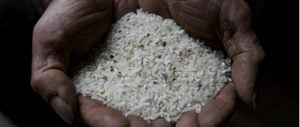Ledu county in western China lies 80 kilometres from Xining, the capital of Qinghai province. A yellow-hued river divides the territory and its 300,000 residents into two halves: Nanshan and Beishan. Three-year-old Rong Tongxi lives with his grandparents in Nanshan, in a typical village of the impoverished north-west called Shangzhangfang.
Playing among a group of children, Rong appears markedly smaller than his peers, an observation borne out by his measurements: 84 centimetres in height and 9.4 kilograms in weight. Chen Chunming, nutrition expert and senior advisor to Chinese Center for Disease Control and Prevention (CCDC), winced when she saw these figures. World Health Organisation standards say healthy three-year-olds should be between 91.1 centimetres and 98.7 centimetres tall. Rong is seven centimetres shorter than even the minimum.
Rong’s grandparents say he eats “normally”, but Chen believes he is suffering moderate stunting, a reduced growth rate brought on by malnutrition in early childhood. Its effects are largely irreversible, and can lead to premature death. At least 10 million pre-school children in China have stunted growth, according to a report from CCDC. It’s the second highest population in the world, behind only India. And the incidence of stunting in infants aged six to 11 months is rising.
Rong’s case is no exception in this corner of China, where flour and potatoes are the staple foods. An Jun, head of the township clinic, said annual check-ups indicate at least 15% of children here suffer light or moderate stunting. It’s a problem shared by many other parts of the country too. A CCDC survey in 2010 suggested 9.9% of children under the age of five have stunted growth. In 2006, children’s charity UNICEF said China had at least 12.7 million stunted children.
But child health experts argue the problem has been largely ignored, both within China and worldwide. “In some areas, stunting is very common, so people mistake it for a genetic and unavoidable disease,” said Gillian Mellsop, UNICEF’s China representative.
Like so many other children, Rong’s fate appears sealed. But fortune has looked differently on children across the river in Beishan. In August 2009, nine villages and towns in this half of Ledu county were selected for an infant development programme, run by the China Development Research Foundation and UNICEF. Protein and iron supplements were handed out to boost the diet of children between six months and two years old. Pregnant women were also given nutrition pills.
Chen Chunming believes this kind of nutritional boost can help to solve the problems of stunting and anaemia caused by childhood malnutrition. The 1,000 days between conception and a child’s second birthday are key, she said.
The project in Beishan is still running, and data collected indicates it has succeeded in reducing malnutrition. In the village of Gonghe, we met boys the same age as Rong Tongxi who had received supplements before the age of two. At 101 centimetres tall and 16.4 kilograms in weight, the difference in their stature was clear.
A follow-up study carried out one year into the project found stunting rates among 12 to 14-month-old children had fallen from 10% to 4.6% in the county, while anaemia rates among children between six and eight-months-old at the start of the programme had fallen by 38.6%.
In fact, child nutrition in China more widely has seen improvements since the economic boom began and the government introduced pro-rural policies. But some argue that optimism has led to complacency – and that fragile improvements are, in places, going into reverse. UNICEF nutritionist Chang Suying pointed out that non-economic factors are also at work, and that child nutrition is very sensitive to slowing economic growth.
CDCC data shows that, since 2005, the rate at which childhood malnutrition is falling has slowed. And, in 2010, as the impacts of the global economic crisis fed through to China, child malnutrition rates even increased in impoverished areas.
While the rate of stunting in children over one year old in China’s poor villages remained static between 2008 and 2009, in 2010 it rebounded to 2005 levels. Stunting in infants aged between six and 11 months doubled between 2008 and 2009, from 6.7% to 12.5%, and remained at 12.1% in 2010.
Rates of anaemia, an important indicator of childhood malnutrition, have also remained stubbornly high. Despite the supplements, anaemia in Ledu county is still at 46.4%. In 2010, the rate of anaemia in children under five nationwide was 12.6%. In children under three in rural areas, the figure was 19.2%. And for under-threes in impoverished rural areas, it was 23.3%.
“Anaemia isn’t just a rural problem – it exists in major cities and coastal areas like Shanghai and Guangdong,” explained Liu Bei, a project officer in Ledu. “The 2010 survey found anaemia rates of 20% in babies and infants in these places, and up to 70% in some impoverished south-western counties.” Like stunting, anaemia has long-lasting and largely irreversible impacts on a child’s development.
Prompted by the achievements in Ledu, at the end of 2011 the Qinghai government provided 10 million yuan (US$1.6 million) to expand the provision of supplements to the whole province. It is the first government-funded project of its kind to cover such a large area, said Chang Suying.
But nationwide, only 130,000 children are receiving these supplements. Chen and other child nutritionists say they are anxiously awaiting the day when more children benefit, especially those in poor villages.
On April 8 this year, it emerged that the Ministry of Health is planning a “nutrition intervention project” for preschool children in impoverished regions of the Luliang mountains, in north China’s Shanxi province. A scheme to provide children aged between six months and six years with free supplements may also be trialled here.
Government involvement offers a ray of hope. But Chen Chunming, who is 87 and has worked on child nutrition for much of her life, believes current efforts are nowhere near adequate. “The problem is how to get nutritious food into the mouths of the children who need it – how to create sustainable distribution mechanisms,” Chen said. “Relying on the Ministry of Health alone isn’t enough”. She may have a point: in the past, funds provided to families to improve nutrition for school-age children ended up being used for other purposes by their parents.
How to make the supply sustainable, how to make it free, how to scale it up – these are questions that must be answered, said Chen, if China is to solve childhood malnutrition.
This article was first published in Southern Weekend, where Yuan Ying is a reporter and Wang Jingyi an intern.
Homepage image by Desmond Kavanagh


